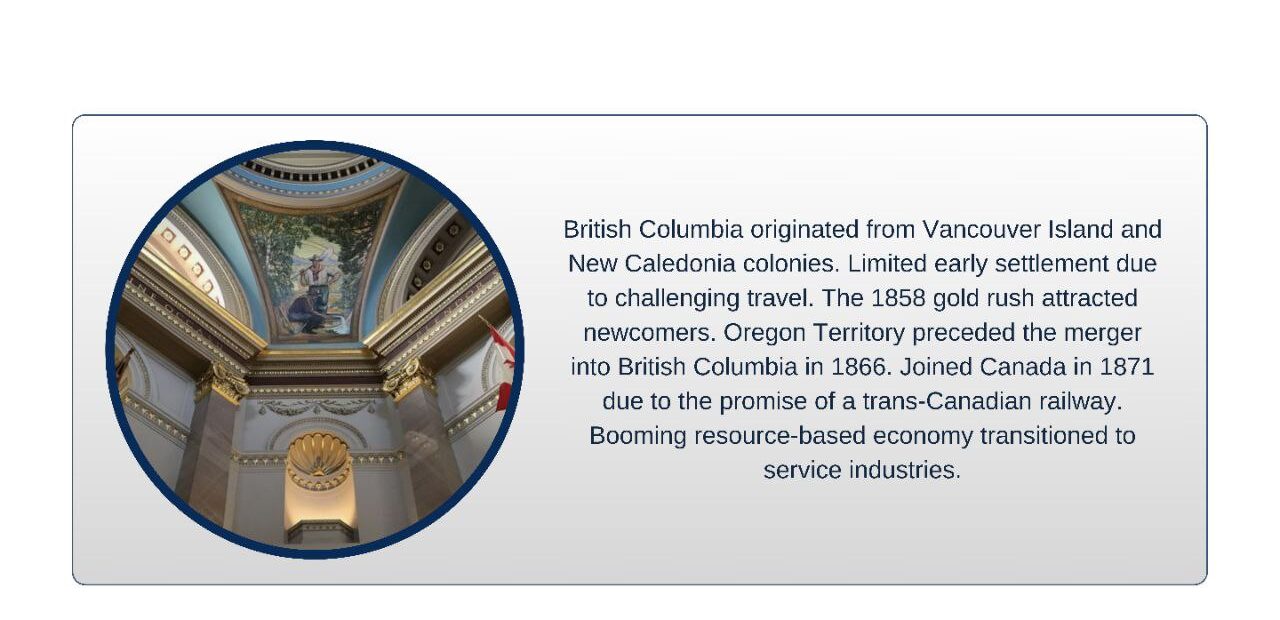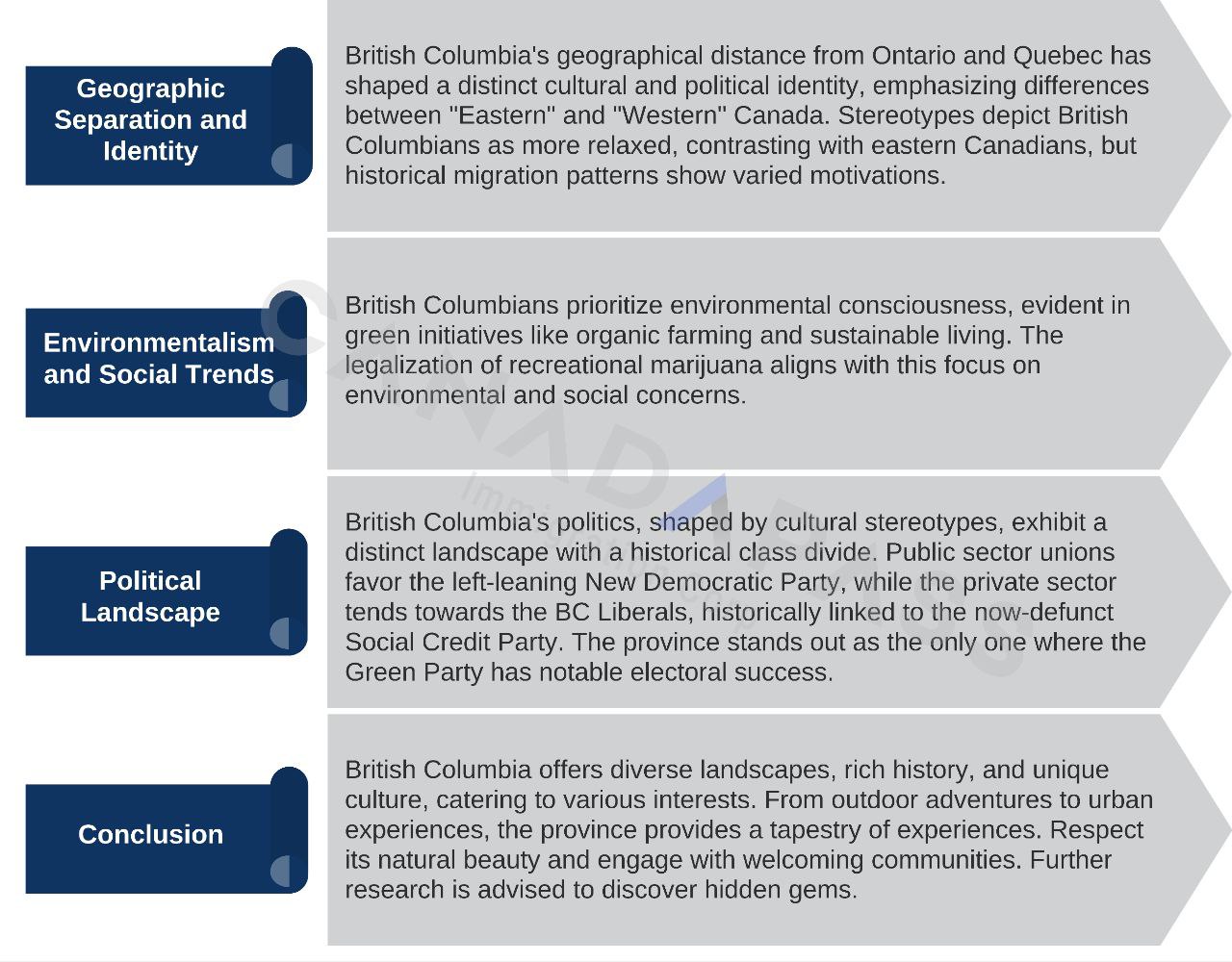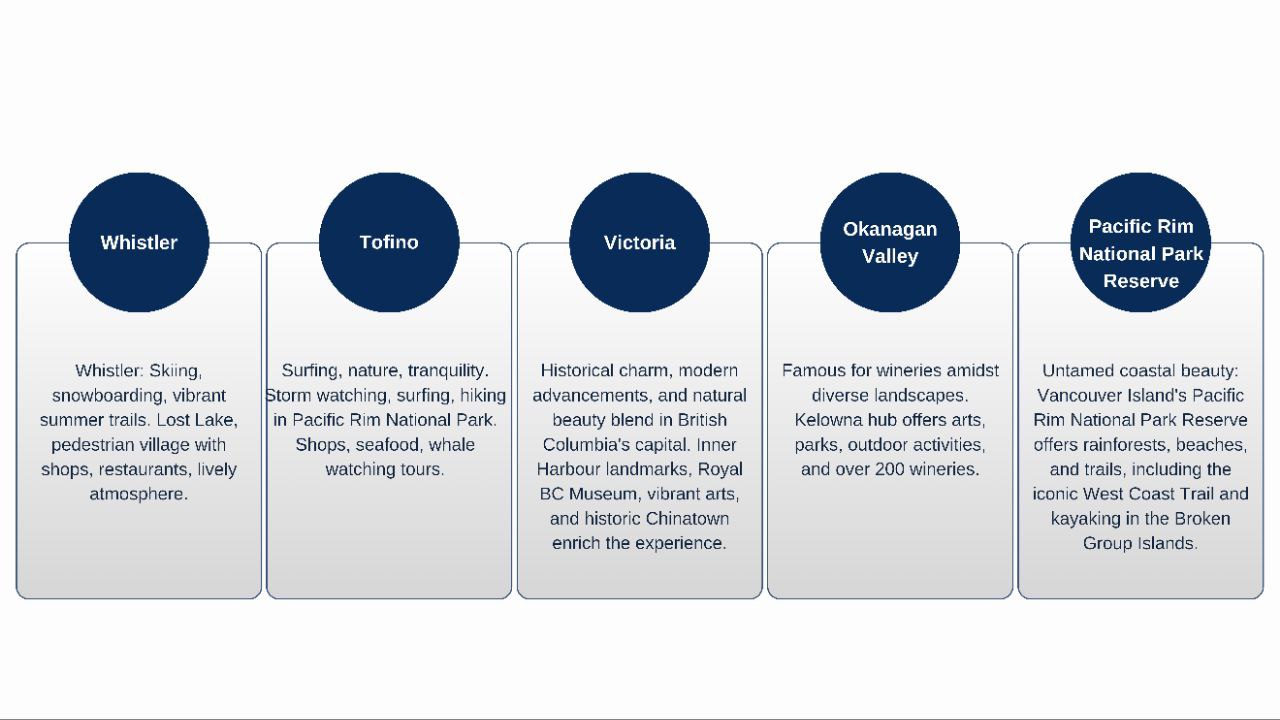Location: Bordering the Pacific Ocean from Alaska to Washington state, British Columbia (often abbreviated as BC) is the westernmost province of Canada.
Climate: Due to its coastal position, BC enjoys a milder climate compared to the rest of the country, known for colder temperatures. This region is often associated with iconic natural landscapes, including towering evergreen trees, cascading waterfalls, and snow-capped mountains.
Population and Culture: With a population ranking third in the nation, BC has developed a somewhat distinct cultural identity due to its geographic distance (over 3,000 miles) from major eastern cities like Toronto, Montreal, and Ottawa. Vancouver, a large coastal city, and its surrounding suburbs form the province’s major population center, while the inland and northern regions remain predominantly rural.

History of British Columbia
The territory known today as British Columbia originated from two distinct colonial entities:
- Vancouver Island: Established in the late 18th century by British and Spanish explorers, this colony encompassed Vancouver Island.
- New Caledonia: Established around the same time by fur traders, this colony encompassed the mainland territory.
Prior to the development of airplanes and railroads, travel to the region was challenging, resulting in a limited population composed primarily of indigenous communities and a small number of white settlers. However, the 1858 gold rush attracted a significant influx of newcomers, many of whom remained as miners or loggers.
Following a brief period of joint U.S.-British rule under the name Oregon Territory, the Island and mainland colonies merged to form British Columbia in 1866. Shortly after the creation of the Dominion of Canada in 1867, pressure mounted from both British and Canadian elites for British Columbia to join the confederation. The promise of a trans-Canadian railway connecting the east and west coasts eventually solidified the agreement, and British Columbia officially became Canada’s sixth province in 1871.
The 19th and 20th centuries witnessed significant advancements in industry and transportation, transforming British Columbia into a major North American hub for natural resources. The province’s trade in lumber, minerals, and fish across the continent fueled a booming economy, leading to the establishment of numerous cities and attracting immigrants from various regions, including nearby Asia. In recent times, British Columbia has transitioned from a resource-based economy towards service industries such as retail, tourism, and software design. However, the resource sector continues to contribute approximately 25% of the province’s gross domestic product.

Geography of British Columbia
British Columbia is part of Canada’s Cordillera region, a distinct geographical area characterized by vast forests, towering mountain ranges, deep valleys, and extensive river systems. The region receives significant rainfall, fostering a diverse range of vegetation, particularly evergreen trees that historically formed the foundation of the province’s lumber industry.
The coastline is a complex network of fjords, rocky coves, and sandy beaches, dotted with numerous islands. Vancouver Island, the largest, houses the provincial capital, Victoria. Further north lies the Haida Gwaii archipelago (formerly Queen Charlotte Islands), a remote yet populated region.
The interior of the province, nestled between the Coast Mountains on the west and the Columbia and Rocky Mountains forming the eastern border with Alberta, features a flatter plateau suitable for agriculture.
British Columbians often divide their province into two major regions:
- Lower Mainland: encompassing the southwestern Vancouver peninsula and its surrounding suburbs.
- Interior: encompassing all other regions.
Northern British Columbia, like most of northern Canada, is generally considered a distinct area with a sparse population. The vast majority of the population resides in the Lower Mainland.
Visiting British Columbia: Top Destinations
British Columbia’s diverse landscapes offer experiences for various travelers. Here are five destinations showcasing the province’s natural beauty and cultural offerings:

1. Whistler
Nestled in the Coast Mountains, Whistler is globally renowned for winter skiing and snowboarding. Its appeal extends beyond winter, with vibrant summer trails for mountain biking and hiking. Lost Lake offers a refreshing escape, while the pedestrian-only village features shops, restaurants, and a lively atmosphere.
2. Tofino
Located on Vancouver Island’s west coast, Tofino is a haven for surfers, nature lovers, and those seeking tranquility. The vast Pacific Ocean allows for storm watching in winter and surfing and sunbathing in summer. Pacific Rim National Park Reserve offers hiking trails within ancient rainforests. The town boasts shops, seafood restaurants, and cozy accommodations. Boat tours offer opportunities to witness whales during migration periods.
3. Victoria
British Columbia’s capital city, Victoria, captivates with its historical charm. Situated on Vancouver Island’s southern tip, it features a blend of historic architecture, modern advancements, and natural beauty. The Inner Harbour, with its iconic Fairmont Empress Hotel and Parliament Buildings, reflects the city’s rich past. The Royal BC Museum showcases the province’s history, while the vibrant arts scene and historic Chinatown offer diverse experiences.
4. Okanagan Valley
Nestled between rolling hills and lakes, the Okanagan Valley is renowned for its wineries. However, the diverse landscapes, ranging from desert terrains in the south to lush forests in the north, offer various activities beyond wine tasting. Kelowna, the valley’s hub, features a vibrant arts scene, waterfront parks, and various outdoor activities like paddleboarding on the lake or exploring hiking trails. Over 200 wineries offer unique experiences, from tastings to tours, amidst stunning scenery.
5. Pacific Rim National Park Reserve
This park reserve embodies the untamed beauty of British Columbia’s coast. Located on Vancouver Island’s west coast, it features a mosaic of temperate rainforests, rugged coastlines, and sandy beaches. Long Beach offers opportunities for surfing and relaxation, while the challenging West Coast Trail rewards hikers with breathtaking views and wildlife encounters. The Broken Group Islands are a kayaker’s paradise, with opportunities to witness marine life and explore the archipelago.
Cost of Living in British Columbia
Overview
The cost of living in British Columbia is higher than the national average in Canada. Here’s a breakdown of average monthly expenses:
- Total: $2,273 CAD (including rent)
- Without Rent: $821 CAD
- Rent & Utilities: $1,452 CAD
- Food: $584 CAD
- Transportation: $102 CAD
Comparison to National Average:
- British Columbia’s cost of living is 1.23 times higher than the national average in Canada.
Salary and Affordability:
- The average monthly salary after tax in British Columbia is $2,935 CAD.
- This salary can cover basic living expenses for approximately 1.3 months.
Additional Notes:
- It’s important to remember that these are average figures, and individual expenses may vary depending on lifestyle choices, location within the province, and family size.
- The ranking of “2nd most expensive” and “6th best state to live in” is removed as it relies on subjective opinions and rankings from external sources.
Cost Breakdown
This section provides an overview of average prices for various goods and services in British Columbia, Canada.
Eating Out:
- Lunch Menu: $14.7 CAD
- Dinner for two at a restaurant: $63.1 CAD
- Fast food meal: $10.2 CAD
- Beer in a pub (0.5 L): $5.3 CAD
- Cappuccino: $3.9 CAD
- Soft drink (0.5 L): $2.16 CAD
Housing:
- Rent for a one-bedroom apartment in the city center: $1,469 CAD
- Rent for a cheap one-bedroom apartment: $1,260 CAD
- Rent for a three-bedroom apartment in the city center: $2,821 CAD
- Rent for a cheap three-bedroom apartment: $2,216 CAD
- Utility bill (electricity, heating, water) for one person: $84.4 CAD
- Utility bill (electricity, heating, water) for a family: $130 CAD
- Monthly internet plan (50 Mbps+): $63 CAD
- Mortgage interest rate (20 years): 6.9%
- Average price per square meter to buy an apartment in the city center: $9,609 CAD
- Average price per square meter to buy a house in the suburbs: $7,103 CAD
Transportation:
- Local transport ticket: $2.44 CAD
- Monthly local transport pass: $88.4 CAD
- Taxi ride (8 km): $16.2 CAD
- Gas/petrol (1 L): $1.34 CAD
Groceries:
- Milk (1 L): $2.18 CAD
- Bread (0.5 kg): $2.48 CAD
- Rice (1 kg): $4.45 CAD
- Eggs (12): $3.90 CAD
- Cheese (1 kg): $12.80 CAD
- Chicken breast (1 kg): $13.50 CAD
- Round steak (1 kg): $17.40 CAD
- Apples (1 kg): $4.33 CAD
- Bananas (1 kg): $1.34 CAD
- Oranges (1 kg): $3.61 CAD
- Tomatoes (1 kg): $4.61 CAD
- Potatoes (1 kg): $2.78 CAD
- Onions (1 kg): $2.88 CAD
- Bottled water (1 L): $1.17 CAD
- Soft drink (2 L): $2.21 CAD
- Wine (mid-priced, 750 ml bottle): $14.00 CAD
- Beer (0.5 L): $3.16 CAD
- Cigarettes (pack): $13.90 CAD
- Cold medicine (1 week supply): $9.14 CAD
Other:
- Gym membership (monthly): $40.5 CAD
- Movie ticket: $12.20 CAD
- Doctor’s visit: $86.60 CAD
- Haircut (simple): $14.10 CAD
- Brand name jeans: $56.20 CAD
- Brand name sneakers: $92.00 CAD
- Daycare or preschool (monthly): $775 CAD
- International primary school (annual tuition): $10,971 CAD
Culture and Politics in British Columbia
Geographic Separation and Identity
British Columbia’s geographical distance from Canada’s major population centers in Ontario and Quebec has fostered a distinct cultural and political identity. This has led to a focus on the perceived differences between “Eastern” and “Western” Canada. Stereotypes portray British Columbians as more relaxed and less ambitious compared to eastern Canadians. While these stereotypes hold some historical basis, they do not encompass the entire population. Historically, individuals seeking a less stressful lifestyle migrated west, while others from British Columbia moved east seeking career opportunities.
Environmentalism and Social Trends
The province’s natural beauty has contributed to a strong environmental consciousness among British Columbians. This is reflected in the popularity of “green” initiatives such as organic farming and sustainable living practices. The legalization of recreational marijuana in the province can also be seen as an extension of this environmental and social focus.
Political Landscape
British Columbia’s political landscape has a reputation for being distinctive, a characteristic often attributed to broader cultural stereotypes. Traditionally, politics have been marked by a pronounced class divide. Public sector unions, particularly those representing teachers, nurses, and government employees, tend to support the left-leaning New Democratic Party. The private sector, historically represented by the now-defunct Social Credit Party and the current BC Liberals, leans towards a more libertarian ideology. Notably, British Columbia is the only province in Canada where the Green Party has achieved significant electoral success.
Conclusion
British Columbia, with its diverse landscapes, rich history, and unique culture, offers something for everyone. Whether you’re seeking outdoor adventure, cultural immersion, or a vibrant urban experience, British Columbia has it all. From the majestic mountains and pristine glaciers to the bustling cities and charming towns, the province provides a tapestry of experiences. As you explore British Columbia, be sure to respect its natural beauty and engage with its welcoming communities. Remember, this information provides a general overview; further research is recommended to plan your trip and uncover the hidden gems this remarkable province has to offer.








